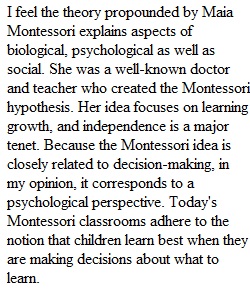


Q Overview Throughout the course, you’ve been exposed to many theorists in life-span development. Now you will work to align their theories to relevant perspectives and explore the foundations of their research. This milestone will prepare you to complete Project Two in Module Seven. You will complete a Theories at a Glance table and answer two short-response questions. Prompt The following resource supports your work on the milestone: • Module Five Milestone Template Using the Module Five Milestone Template, you must address Part One and Part Two of the rubric criteria listed below: Part One: Theories at a Glance Table • Identify the appropriate perspective(s) that best relate to each theorist by inserting an ‘X’ under the appropriate perspective column. It is possible that some theorists may apply more than one perspective. • Identify the primary theoretical concept(s) of each theorist and provide a brief explanation of the perspective-theorist alignment you identified. Part Two: Short-Response Questions • Identify a theorist from the Theories at a Glance Table, summarize their theory, and explain the aspects of that theory that relate to one of the three perspectives: biological, psychological, or social. Support your answer with a credible source. • Select another theorist from the Theories at a Glance Table and explain how their theory applies to your own learning development and lived experience. Guidelines for Submission Submit your completed Module Five Milestone Template. Sources should be cited according to APA style. Module Five Milestone Rubric Criteria Exemplary (100%) Proficient (85%) Needs Improvement (55%) Not Evident (0%) Value Appropriate Perspectives N/A Identifies appropriate perspectives for each theorist (100%) Shows progress toward proficiency, but with errors or omissions (55%) Does not attempt criterion (0%) 10 Concept(s) Exceeds proficiency in an exceptionally clear, insightful, sophisticated, or creative manner (100%) Identifies primary theoretical concept(s) of each theorist and provides explanation for the identified perspective-theorist alignment (85%) Shows progress toward proficiency, but with errors or omissions; areas for improvement may include accuracy of primary theoretical concepts identified or details related to explaining the validity of the identified perspective-theorist alignment (55%) Does not attempt criterion (0%) 30 Perspectives Exceeds proficiency in an exceptionally clear, insightful, sophisticated, or creative manner (100%) Identifies a theorist, summarizes their theory, and explains the aspects of that theory that relate to one of the three perspectives, supporting answer with a credible source (85%) Shows progress toward proficiency, but with errors or omissions; areas for improvement may include details related to identifying a theorist, summarizing their theory, and explaining the aspects of that theory that relate to one of the three perspectives (55%) Does not attempt criterion (0%) 23 Learning Development Exceeds proficiency in an exceptionally clear, insightful, sophisticated, or creative manner (100%) Selects one theorist and explains how their theory applies to student’s learning development and lived experience (85%) Shows progress toward proficiency, but with errors or omissions; areas for improvement may include details related to selecting one theorist and explaining how their theory applies to student’s learning development and lived experience (55%) Does not attempt criterion (0%) 23 Articulation of Response Exceeds proficiency in an exceptionally clear, insightful, sophisticated, or creative manner (100%) Clearly conveys meaning with correct grammar, sentence structure, and spelling, demonstrating an understanding of audience and purpose (85%) Shows progress toward proficiency, but with errors in grammar, sentence structure, and spelling, negatively impacting readability (55%) Submission has critical errors in grammar, sentence structure, and spelling, preventing understanding of ideas (0%) 9 Citations and Attributions Uses citations for ideas requiring attribution, with few or no minor errors (100%) Uses citations for ideas requiring attribution, with consistent minor errors (85%) Uses citations for ideas requiring attribution, with major errors (55%) Does not use citations for ideas requiring attribution (0%) 5 Total: 100%
View Related Questions